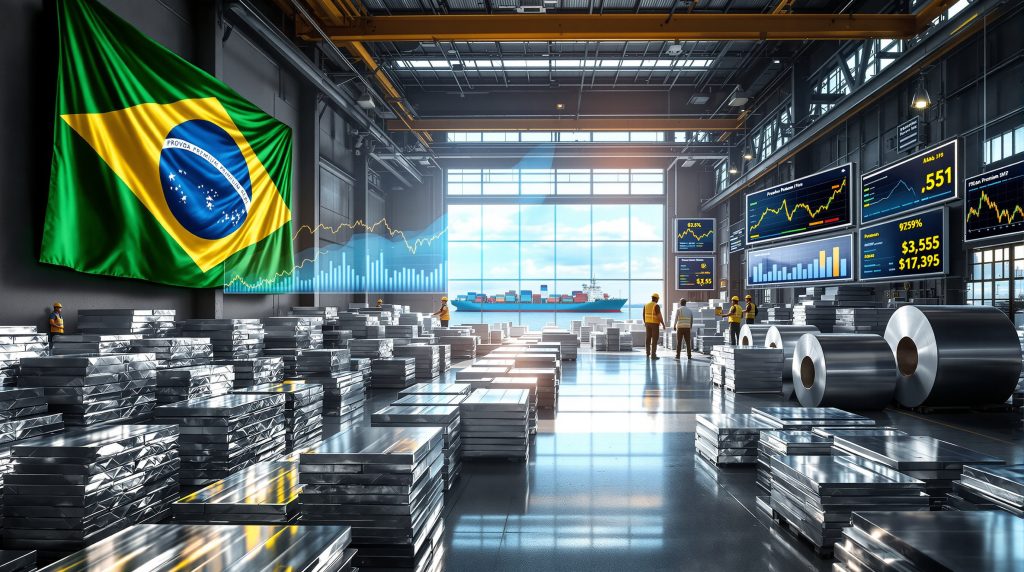Brazil’s Aluminium Industry: Navigating Global Competition Amid US Tariff Pressures
The implementation of 50% import tariffs by the United States in March 2025 has triggered significant shifts in global aluminium trade flows, with Brazil experiencing both challenges and opportunities. These US steel & aluminum tariff rules have forced international producers to seek alternative markets, increasingly viewing Brazil as a viable destination for their products.
Market Redirection and Import Surge
Brazilian aluminium imports have risen notably, reaching 263,210 tonnes during January-July 2025—an increase from 246,832 tonnes during the same period in 2024. This 6.6% growth reflects the redirection of global aluminium supplies originally destined for US markets.
The surge in imports comes as international producers adapt their strategies to navigate an evolving global trade landscape. Market participants note this redirection is part of a broader restructuring of aluminium trade flows worldwide, with material previously headed to American customers now finding its way to Brazilian shores.
Premium Erosion in Brazilian Markets
The influx of international aluminium has placed downward pressure on domestic premiums:
| Premium Type | March 2025 (Pre-tariff) | August 2025 (Post-tariff) | Change |
|---|---|---|---|
| P1020A premium, high-VAT market (São Paulo) | $130-170 per tonne | $110-130 per tonne | ↓ 15-23% |
| P1020A premium, low-VAT market (São Paulo) | $240-290 per tonne | $215-250 per tonne | ↓ 10-14% |
| 6063 & 6060 extrusion billet premium (Brazilian main ports) | Historical high | $310-340 per tonne (lowest since Sept 2024) | Significant decline |
This premium erosion indicates increasing competitive pressure on local producers as international suppliers aggressively pursue market share in Brazil. While beneficial for downstream consumers of aluminium products, this trend presents margin challenges for domestic producers.
Which Global Players Are Targeting Brazil’s Aluminium Market?
The realignment of global aluminium trade has attracted major international producers to Brazil, intensifying competition for domestic manufacturers.
New Market Entrants and Expansion Efforts
Several global aluminium giants have increased their focus on Brazil:
- Vedanta (India): Already established in Brazil, the company has significantly increased its export volumes to the country
- Rusal (Russia): Market sources confirm the company has initiated test shipments and sales efforts in Brazil
- Other International Suppliers: Multiple traders report increased interest from various global producers seeking to redirect capacity from US markets
This influx of international competition represents a fundamental shift in Brazil’s aluminium industry landscape. Historically, domestic producers have dominated the local market, but the tariffs affecting mining sector have accelerated the entrance of global competitors seeking alternative sales channels.
Brazilian Producers’ Strategic Response
Major domestic producers have maintained their focus on serving the local market:
- Companhia Brasileira de Alumínio (CBA): Directs over 90% of production to domestic customers
- Alumar: Operating near full capacity with plans to reach 100%, primarily serving Brazilian demand
- Albras: Continues prioritizing domestic supply despite changing global trade patterns
Brazilian producers benefit from established customer relationships, supply chain integration, and proximity advantages that international competitors struggle to match. However, their strategic focus on the domestic market leaves them vulnerable to increased competition as imports rise.
What Economic Impacts Have US Tariffs Created for Brazil’s Aluminium Sector?
The 50% US tariffs have generated significant economic consequences for Brazil’s aluminium industry, affecting both export potential and domestic market dynamics.
Export Reduction and Financial Losses
- 25% decrease in Brazilian aluminium exports to the US during H1 2025
- Projected financial losses of approximately $210 million for Brazilian producers in 2025
- Redirection of export capacity toward domestic and alternative international markets
These losses represent a substantial economic impact, forcing Brazilian producers to reconsider their market positioning and strategic priorities. While the direct export relationship with the US wasn’t dominant for all producers, the broader market disruption has created ripple effects throughout the industry.
Domestic Market Price Pressures
The influx of international aluminium has created a more competitive pricing environment:
- Newly launched domestic premium for Brazilian 6063 & 6060 extrusion billet (São Paulo) established at $470-530 per tonne in August 2025
- Widening of the P1020A premium for Brazilian main ports to $250-280 per tonne by late August 2025
These price dynamics reflect the growing competition between domestic and imported material, creating both challenges and opportunities across the value chain. Downstream manufacturers benefit from more competitive input costs, while primary producers face margin compression.
How Are Brazilian Producers Adapting to Changing Market Conditions?
Brazil’s aluminium industry is implementing strategic adjustments to navigate the evolving competitive landscape.
Production Capacity Optimization
- Alumar: Pursuing capacity expansion toward 100% utilization, focusing primarily on domestic market supply
- Strategic Domestic Focus: Major producers maintaining their emphasis on serving Brazilian customers rather than pursuing export markets
This capacity optimization strategy reflects a recognition that domestic market security may prove more valuable than export opportunities in an increasingly protectionist global environment. By securing strong positions in the Brazilian market, producers aim to maintain stability amid international disruption.
Market Positioning and Value Propositions
Brazilian producers are leveraging several competitive advantages:
- Supply Chain Reliability: Proximity to domestic customers reduces logistics costs and delivery times
- Customization Capabilities: Ability to meet specific local requirements more efficiently than imported alternatives
- Regulatory Familiarity: Better positioned to navigate Brazil’s complex tax and compliance environment
These advantages help domestic producers maintain strong customer relationships despite pricing pressures from imports. The localization benefits create a value proposition that international competitors struggle to match, particularly for specialized applications requiring close technical collaboration.
What Are the Long-Term Implications for Brazil’s Aluminium Industry?
The current market disruptions present both challenges and opportunities that will shape the future of Brazil’s aluminium sector.
Structural Market Changes
- Increased international competition may drive efficiency improvements and innovation among domestic producers
- Potential for industry consolidation as smaller players face margin pressures from import competition
- Development of more sophisticated pricing mechanisms and risk management strategies
These structural changes suggest a fundamental transformation of Brazil’s aluminium industry rather than a temporary disruption. The competitive pressures are likely to drive operational excellence initiatives while potentially accelerating consolidation among less efficient producers.
Strategic Investment Considerations
- Opportunities for capacity expansion to serve growing domestic demand, particularly in construction and automotive sectors
- Potential for downstream integration to capture additional value and differentiate from import competition
- Investment in energy efficiency and sustainability initiatives to reduce production costs and meet evolving market requirements
The current market challenges may accelerate strategic investments as producers seek to strengthen their competitive positioning. Energy efficiency investments are particularly critical given the energy-intensive nature of aluminium production and its significant impact on overall cost structures.
How Does Brazil’s Position Compare to Other Global Aluminium Markets?
Brazil’s situation reflects broader global trends in aluminium markets, with some distinctive regional characteristics.
Comparative Market Dynamics
- Similar redirection of exports to European markets, though with different premium impacts
- Regional variations in energy costs significantly influence production economics and competitive positioning
- Brazil’s abundant bauxite reserves provide potential long-term advantages for integrated producers
Brazil’s position as both a major bauxite producer and aluminium manufacturer creates unique dynamics compared to regions that must import raw materials. This integrated value chain potential represents a strategic advantage if properly leveraged through investment and operational efficiency.
Global Supply Chain Reconfiguration
The US tariffs have accelerated changes in global aluminium supply chains:
- Increased emphasis on regional supply networks to minimize trade policy risks
- Growing importance of sustainability credentials and carbon footprint in market access
- Evolving customer preferences for supply security over lowest-cost sourcing
These supply chain shifts reflect a broader deglobalization trend affecting many industrial sectors. For Brazil’s aluminium industry, this represents both a challenge in terms of export potential and an opportunity to strengthen domestic value chains through greater integration and localization.
What Should Market Participants Monitor Going Forward?
Several key indicators will shape the evolution of Brazil’s aluminium market in coming months.
Critical Market Signals
- Premium differentials between domestic and imported material
- Capacity utilization rates among major Brazilian producers
- Import volumes and country-of-origin shifts
- Potential trade policy responses from Brazilian authorities
These indicators provide important insight into market dynamics and competitive positioning. Monitoring these metrics allows stakeholders to anticipate shifts in market balance and respond strategically to evolving conditions.
Industry Response Strategies
- Pricing mechanism adaptations to accommodate increased commodities trade volatility
- Product differentiation initiatives to compete with imported alternatives
- Industry advocacy efforts regarding trade policy and energy costs
The industry’s collective response to competitive pressures will significantly influence its future trajectory. Collaboration on issues like energy policy and trade advocacy may become increasingly important as international competition intensifies.
FAQ: Brazil’s Aluminium Industry and US Tariffs
How significant is the US market for Brazilian aluminium exports?
While not the primary destination, the US has been an important export market. The 25% decline in exports to the US during H1 2025 represents a meaningful shift in trade patterns, though most major Brazilian producers maintain their strategic focus on domestic customers.
Are Brazilian producers considering retaliatory measures?
Individual producers have limited options for retaliation, though industry associations have advocated for government action. According to AlCircle, Brazil has considered implementing reciprocal tariffs on select US goods, though such measures remain under evaluation.
How are energy costs affecting Brazil’s aluminium competitiveness?
Brazil’s heavy reliance on hydroelectric power creates both advantages and challenges. While generally renewable, hydropower costs can fluctuate significantly with rainfall patterns, affecting production economics and competitive positioning.
What downstream sectors in Brazil are most affected by aluminium market changes?
Construction, packaging, and automotive manufacturing represent the largest domestic consumers of aluminium products. These sectors face both opportunities from potentially lower input costs and challenges from supply chain disruptions.
Navigating a Transformed Competitive Landscape
Brazil’s aluminium industry finds itself at a pivotal moment as global trade patterns undergo significant restructuring. The 50% US import tariffs have accelerated competitive pressures within the Brazilian market while simultaneously creating potential opportunities for domestic producers to strengthen their market positions.
The industry’s future success will depend on strategic adaptability, operational efficiency improvements, and the ability to leverage Brazil’s inherent advantages in bauxite project benefits and domestic market access. While international competition has intensified, Brazilian producers maintain significant competitive advantages through their established customer relationships, supply chain integration, and understanding of local market requirements.
As global aluminium trade continues to evolve, Brazil’s position as both a producer and increasingly important consumption market ensures its ongoing significance in the industry’s future development. The tariffs impact investment decisions and strategic responses of domestic producers to current challenges will shape their competitive positioning for years to come.
Further Exploration:
Readers interested in learning more about global aluminium markets and trade policy impacts can explore related educational content at BNAmericas, which offers additional perspectives on aluminium industry developments.
Want to Capitalise on the Next Major Mineral Discovery?
Don’t miss potential market-moving opportunities in the mining sector. Explore Discovery Alert’s dedicated discoveries page to understand how historic findings generated substantial returns, and start your 30-day free trial today to receive real-time alerts powered by the proprietary Discovery IQ model at https://discoveryalert.com.au/discoveries/.




